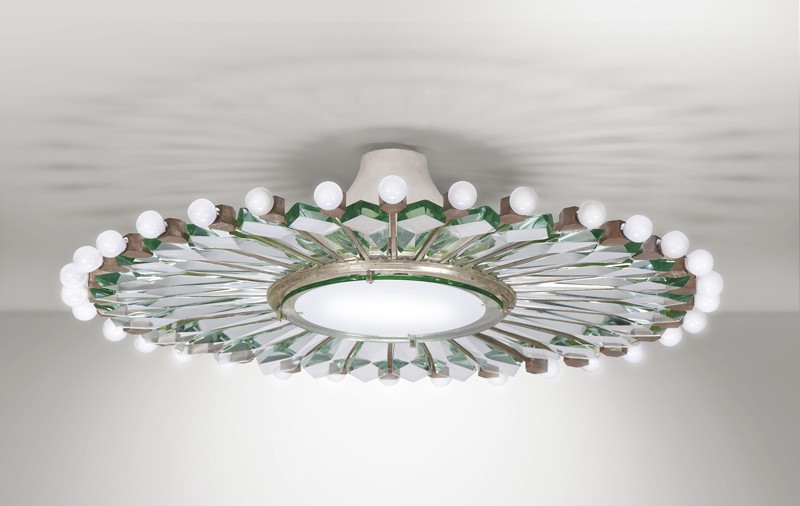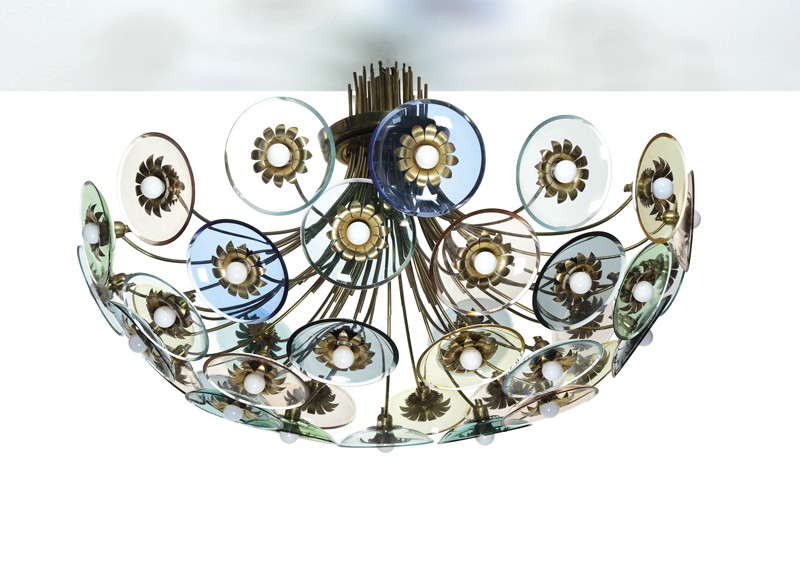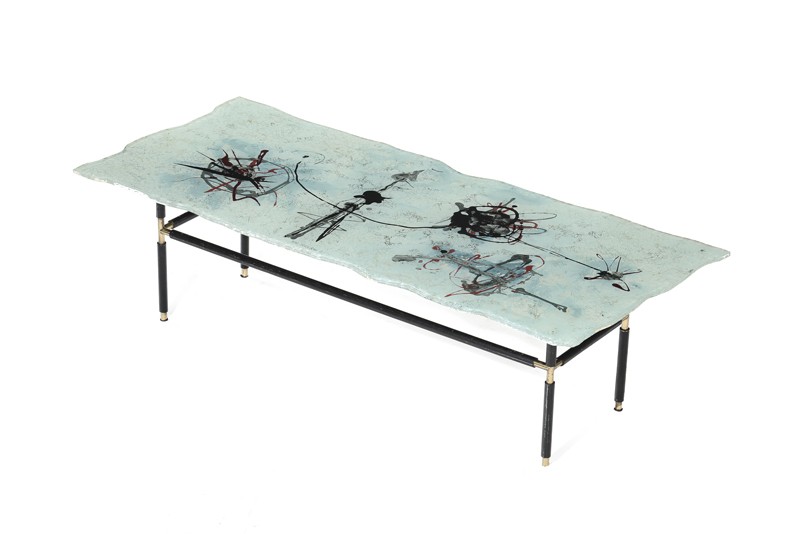Andrea Pietro Mori
Speaking of Pietro Chiesa and Max Ingrand, what remains is one of the finest modern stories of genius and Italian passion. A story at Olivetti, made of culture, professionalism; pervaded with humanity, with men who were able to build something unique, engaging other men, one by one, one after another. Manpower and creative genius together, each one sharing the efforts of others, have helped to guide the artistic and artisan Italian tradition to the modern century in years of great cultural and creative flurry, in which the myth of Italian design was born.
A story of men. Four were the architects of this extraordinary success: Luigi Fontana, an aristocratic entrepreneur, charismatic stimulus for all the workers, who had, among the others, the credit for discovering a young Gio Ponti; Gio Ponti, himself, who sensed the enormous design potential of crystal applied to new lighting systems and furnishing, and who was able to recognize the creative genius of Pietro Chiesa, giving him with the artistic co-direction; Pietro Chiesa, the architect of the international success; Max Ingrand, who, after the sudden death of Chiesa and the damages of the war managed to rebuild the company, upgrading the production and leading it into the design world as we know it today.
Fontana Arte represents a unique example; a company specialized in the use of crystals applied to lighting and furnishing, characterized by modernity of design and perfect execution, originally a specialized field of Luigi Fontana & Compagni, founded by Luigi Fontana in a period of high growth in the use of glass sheets in building. Its varied history, restless, dynamic, in this current period of crisis may be a positive example of how we Italians have been able, and still are, to do business.
The company invested immediately in the territory, on the location of resources, human and not: it invested heavily on technological equipment and training, adding to the normal glass processing, cutting, grinding, silvering, decoration, binding, all operations that were previously mostly carried out abroad, since there were no specialized companies in these fields in Italy.
It invested on distribution, advertising and promotion. The company took part in almost all exhibitions and national and international events.
After having had to rely on foreign countries for a long time for the supply of the glass plates, in 1893 Saint-Gobain opened a manufacturing plant in Pisa, and the Fontana could start to stock up more easily in the domestic market.
It is the beginning of the ascent. In 1910, Saint-Gobain decided to invest in this emerging Italian company as major shareholder and turning the Luigi Fontana into a Inc. Company. The intake of large amounts of capital made it possible to realize new projects.
Fontana continued to be the leader and invested with increasing intensity in culture and technology. It was decided to focus on the emerging market of furniture design and modern lighting. He managed to get the creative director at Richard Ginori, Gio Ponti, at the time a young but already acknowledged Milanese designer; Ponti found in Pietro Chiesa the professional and cultural person for launching a new production type. Ponti and Fontana did not invest only on a man of extraordinary artistic culture, capable of ranging from the most advanced modernism to the most pure and refined decoration, but acquired his “Bottega” and his extraordinary team of craftsmen. Therefore, in 1933 Fontana Arte was set up, a department specialized in modern furnishings.
Within a few years the fledgling enterprise was established and developed enough to employ more than a hundred workers including cutters, engravers, cabinet makers, grinders, coppersmiths, a team of highly skilled workers that Pietro Chiesa had chosen and followed step by step, directing, teaching, stimulating. Fontana Arte, in its own advertising, is defined as industry of “crystal and mirror art objects, engraved glasses, crystal art furniture, lamps, sacred stained glass, modern stained glass windows, ornaments for the table, large crystal decorations.” The production stood out for the refinement of execution and the precious materials used. It is very “luxury” and, although it defined itself as “industrial”, is handcrafted: objects are produced in small series, furniture is often unique. It is a mark of quality and in the 1930s all upper middle class houses had at least a Fontana Arte vase or lamp.
Then the war, the following crisis and the rebirth with Max Ingrand.But I want to stop here, still dwelling on this mostly Italian story, Made in Italy; a story about genius and culture of our professionals, of tradition and skill of our specialized workers, of success and quality that can be achieved if wisely directed to the manufacturing of high quality objects.
A story that is incentive to invest on the Italian excellence, its products, its workers and on the designers who can shape it.
Speaking of Pietro Chiesa and Max Ingrand, what remains is one of the finest modern stories of genius and Italian passion. A story at Olivetti, made of culture, professionalism; pervaded with humanity, with men who were able to build something unique, engaging other men, one by one, one after another. Manpower and creative genius together, each one sharing the efforts of others, have helped to guide the artistic and artisan Italian tradition to the modern century in years of great cultural and creative flurry, in which the myth of Italian design was born.
A story of men. Four were the architects of this extraordinary success: Luigi Fontana, an aristocratic entrepreneur, charismatic stimulus for all the workers, who had, among the others, the credit for discovering a young Gio Ponti; Gio Ponti, himself, who sensed the enormous design potential of crystal applied to new lighting systems and furnishing, and who was able to recognize the creative genius of Pietro Chiesa, giving him with the artistic co-direction; Pietro Chiesa, the architect of the international success; Max Ingrand, who, after the sudden death of Chiesa and the damages of the war managed to rebuild the company, upgrading the production and leading it into the design world as we know it today.
Fontana Arte represents a unique example; a company specialized in the use of crystals applied to lighting and furnishing, characterized by modernity of design and perfect execution, originally a specialized field of Luigi Fontana & Compagni, founded by Luigi Fontana in a period of high growth in the use of glass sheets in building. Its varied history, restless, dynamic, in this current period of crisis may be a positive example of how we Italians have been able, and still are, to do business.
The company invested immediately in the territory, on the location of resources, human and not: it invested heavily on technological equipment and training, adding to the normal glass processing, cutting, grinding, silvering, decoration, binding, all operations that were previously mostly carried out abroad, since there were no specialized companies in these fields in Italy.
It invested on distribution, advertising and promotion. The company took part in almost all exhibitions and national and international events.
After having had to rely on foreign countries for a long time for the supply of the glass plates, in 1893 Saint-Gobain opened a manufacturing plant in Pisa, and the Fontana could start to stock up more easily in the domestic market.
It is the beginning of the ascent. In 1910, Saint-Gobain decided to invest in this emerging Italian company as major shareholder and turning the Luigi Fontana into a Inc. Company. The intake of large amounts of capital made it possible to realize new projects.
Fontana continued to be the leader and invested with increasing intensity in culture and technology. It was decided to focus on the emerging market of furniture design and modern lighting. He managed to get the creative director at Richard Ginori, Gio Ponti, at the time a young but already acknowledged Milanese designer; Ponti found in Pietro Chiesa the professional and cultural person for launching a new production type. Ponti and Fontana did not invest only on a man of extraordinary artistic culture, capable of ranging from the most advanced modernism to the most pure and refined decoration, but acquired his “Bottega” and his extraordinary team of craftsmen. Therefore, in 1933 Fontana Arte was set up, a department specialized in modern furnishings.
Within a few years the fledgling enterprise was established and developed enough to employ more than a hundred workers including cutters, engravers, cabinet makers, grinders, coppersmiths, a team of highly skilled workers that Pietro Chiesa had chosen and followed step by step, directing, teaching, stimulating. Fontana Arte, in its own advertising, is defined as industry of “crystal and mirror art objects, engraved glasses, crystal art furniture, lamps, sacred stained glass, modern stained glass windows, ornaments for the table, large crystal decorations.” The production stood out for the refinement of execution and the precious materials used. It is very “luxury” and, although it defined itself as “industrial”, is handcrafted: objects are produced in small series, furniture is often unique. It is a mark of quality and in the 1930s all upper middle class houses had at least a Fontana Arte vase or lamp.
Then the war, the following crisis and the rebirth with Max Ingrand.But I want to stop here, still dwelling on this mostly Italian story, Made in Italy; a story about genius and culture of our professionals, of tradition and skill of our specialized workers, of success and quality that can be achieved if wisely directed to the manufacturing of high quality objects.
A story that is incentive to invest on the Italian excellence, its products, its workers and on the designers who can shape it.


